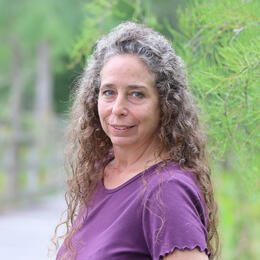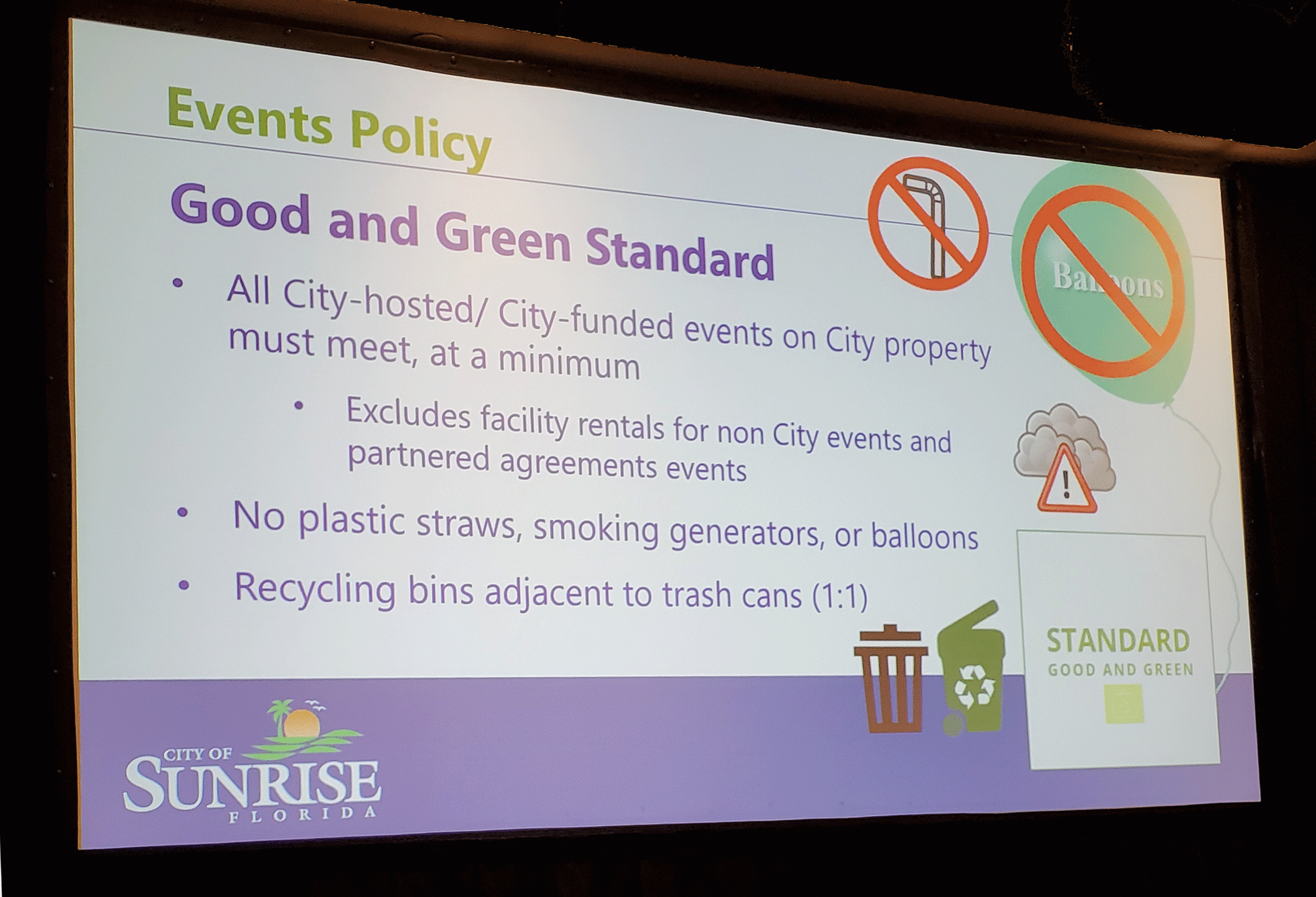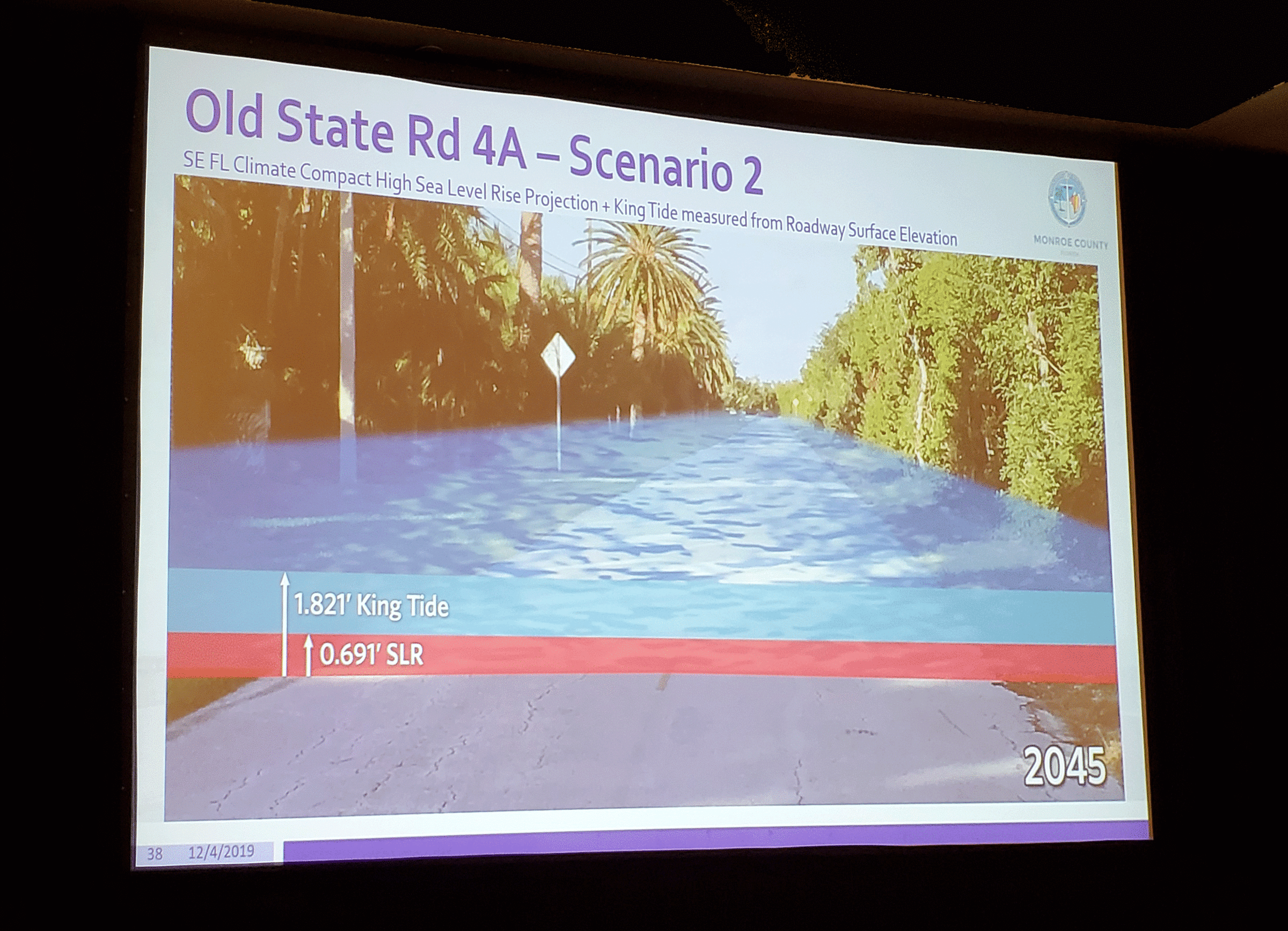The Southeast Florida Regional Climate Leadership Summit, held Dec. 3-5 in Key West, convened nearly 500 professionals working across public and private sectors to share ideas and solutions related to climate change impacts in our state. The 11th annual event, themed “Bridging the Gap,” is a product of the SEFL Climate Compact, which includes municipalities from across Monroe, Miami-Dade, Broward, and Palm Beach Counties.
Following a welcome that included a reading from Greta Thunberg’s speech to the U.N. Climate Summit earlier this year, the Innovation Symposium featured representatives from 14 small municipalities and three mega-cities who shared resilience plans and programs being implemented on the municipal level. Most of the cities and towns were represented by their sustainability coordinators.
Some examples of their innovations included:
- Monroe County Extension shared tools for smaller municipalities to gain momentum, including the Sustainable Floridians program which provides tools for businesses and individuals.
- Coral Gables touted, among other things, their investment in electric vehicles: with 53 (10% of their fleet) they have the largest municipal fleet of EVs in Florida.
- Miami Beach shared concepts from their Buoyant City program, as well as a business case analysis for their stormwater resiliency program.
- North Bay Village, located on two small islands in Biscayne Bay, explained how helpful the Compact has been to their efforts toward sustainability, having implemented a number of incentive policies for businesses and individuals including a fertilizer ordinance and a ban on single-use plastic.
- Boynton Beach, one of the first cities to join the compact, shared details of their Green Building ordinance and Energy Edge rebate program.
- The City of Sunrise shared their “Good and Green” events policy, which is implemented at 30 events they host annually.
There were many others.
A second round of five-minute presentations featured a private sector showcase of innovations in engineering, management, data analytics, communications, and other industries. We also learned about Localecopia, a program that pairs local farmers and food providers with restaurants and chefs to minimize greenhouse gas emissions that typically come from transporting produce and other goods from traditional, larger-scale operations.
The program closed with a facilitated discussion focusing on Resiliency Florida, promoting “1 Voice 1 State,” with lessons learned from municipalities working to make their cities more resilient, and guidance for those just getting started. A poster session and networking reception enabled exhibitors, sponsors, and participants to mingle while learning about relevant products and services.
Day 2
The unofficial theme for Day 2 was “Courageous Communication,” a word that has been used to refer to honest talks about planned retreat from certain coastal areas. Panelists such as Mayor Deb Gillis with the Village of Islamorada provided messages on the importance of taking bold action and taking it now. Islamorada has recently updated its building code, while the neighboring town of Marathon has transitioned to centralized wastewater at the cost of $1b; a worthwhile investment considering they are now enjoying the benefits the restoration has brought about to their nearshore water quality. Marathon is now considering the effects of sea-level rise on every project they undertake.
One of the Compact’s founders, Steve Adams, shone a spotlight on the importance of the Compact bridging a gap between science and action, and also acknowledged a gap in equity that is becoming known as “climate gentrification,” specifically when developers are looking at and buying land situated higher ground. In Miami, some of the lower-income neighborhoods are on the highest elevation land. Equitable climate change policies need to include plans that protect residents in these areas.
Along these lines, resilience and health are connected via heat issues, clean water, and air quality, for example, especially in low-income communities. The Keys already had an affordable housing crisis, and with federal assistance, a property buy-back program is underway, but proposals are badly needed to build low-cost, resilient homes with efficient HVAC systems.
Another common theme was that working together makes the impossible possible and that partnerships are necessary tools for improving resilience.
The Front Office Perspectives panel included administrators from the four counties of the compact who are responsible for preparing budgets for their elected officials to approve. They share many common concerns, from flooding and salt-water intrusion to the quality of waters flowing in and out of Lake Okeechobee. These issues impact our entire state, which relies on clean water for drinking and for agriculture to feed Florida and beyond.
The business community is critical to helping everyone come together to wake up the state of Florida. Under the leadership of their respective chambers of commerce, many businesses are willingly adopting resiliency measures, and public/private partnerships can make a solid business case for resilience. The same can be said for stronger building codes, which proved their worth after Hurricane Irma. Updated codes will also prove crucial for financial resilience considering the increasing cost of insurance.
One of the most powerful discussions on Day 2 was during the Celebrating Milestones presentation, which, not so coincidentally, put a price tag on raising three miles of road infrastructure that has experienced localized flooding for months on end. Monroe County Sustainability Coordinator Rhonda Haag explained that their County-wide Road Adaptation Plan is one of the first of its kind in the country, and the county is now merging data with engineering and planning for policy decisions since what works for one island doesn’t work for another.
Haag explained that, when they first started working on the plan in 2018, their estimates to raise all of the roads in the county at that time were pegged at around $1 billion. Then she shared a newly-released sea level rise projection, which shows an increase of five inches above the median sea level previously predicted for the next 50 years. Monroe County was already building their roads two feet above current FEMA code, but when they ran the models for a constantly-submerged road on Sugarloaf Key with the new projections, and then added the effect of King Tides, it became clear that the roads would need to be raised a minimum of three feet. Because roads elevated to this level require underground infrastructure to move and clean stormwater runoff, the cost skyrocketed. New estimates for the three-mile project landed between $75-181 million, and the Keys has roughly 300 total miles of paved roadways. Monroe County now faces difficult decisions on if, where, and how much is prudent to invest in this infrastructure.
The panel also provided advice on how emerging municipalities can move forward. Suggestions included figuring out unknowns to help with decisions, not being afraid to ask for help, assembling a core team with many skill sets, and being flexible.
The Keynote Presentation delivered a refreshing departure from the Florida heat: a lecture on permafrost. After watching a segment on the TV news program “60 Minutes,” summit organizers reached out to Dr. Robert Max Holmes, deputy director and senior scientist at Woods Hole Research Center. He explained his work with Siberian researchers to study the carbon levels trapped in permafrost and showed us that there is a lot more carbon frozen in permafrost than in all of the fossil fuels underground. Once air temperatures rise high enough for permafrost to melt, it exposes and thaws millions of years of dead plant roots. Dormant microbes awake and begin munching on the roots, releasing methane, a greenhouse gas. Because the microbes are creating heat in this process, they, too, are accelerating the thawing while augmenting greenhouse gas emissions significantly. And, excess snow cover brought about by shifting precipitation patterns is also problematic for keeping permafrost frozen.
The Siberian scientists shared more details on trickle-down effects of melting permafrost on nesting birds, as well as potential solutions for keeping it frozen through land and livestock management practices.
Just after lunch, we heard from Florida’s Chief Resilience Officer Dr. Julia Nesheiwat. She acknowledged that, with just five inches of sea-level rise, the majority of Key West will be subject to daily flooding unless changes are made in the near term. A 12-inch rise can risk $4 billion in taxable property value. She advocated for climate adaptation through technology and innovation, clean energy, and natural infrastructure, and even touted the recent opportunity she had to see pelicans while touring a shoreline restoration project at Alafia Bank Bird Sanctuary in Tampa Bay with Audubon Florida.
Nesheiwat concluded that she will be fostering collaboration as she implements risk management projects, reviews Best Management Practices, and identifies natural infrastructure projects such as mangrove restoration to provide shoreline protection and support the growth of plants and animals while trapping carbon.
The View from the Dais panel explained the importance of bipartisanship in achieving shared goals in local government, and the need to see more legislative action. Another gap to bridge is getting from planning to action, but more research and a strong economy are necessary for the most effective response. This compact has led the nation in collaborative partnerships, and more compacts will lead to more leverage.
Helping residents become resilient while avoiding displacement was a common concern. Many of the residences in the Keys that were affected by Hurricane Irma are being replaced with more expensive structures, often priced out of workers’ budgets. Some communities are looking to locate new low-income housing near transportation hubs. But, more incentive is needed for developers to build low-cost housing: some municipalities are even donating property to lower the builders’ costs.
Miami-Dade shared details of an agreement with FPL to float solar panels on lakes at the airport and install at landfills. Smart traffic signals are being considered to reduce wait times and lower emissions from idling vehicles. They are also using stormwater runoff to fight saltwater intrusion. All of these innovative ideas will help the economy and create jobs.
A Blue Infrastructure panel discussed the need to ensure water quality and availability, as a community is not resilient if it doesn’t have clean water. The Florida Resilient Coastlines Initiative was touted as one funding source providing $5.5 million for water quality improvement projects. Efforts like this are critical to securing the future of our coral reefs, which are the first line of defense protecting the mainland from coastal storms but have been subject to bleaching events, disease, and ocean acidification.
Ocean and fisheries research initiatives are showing that some commercially valuable fish populations are moving poleward as the oceans absorb more heat, while other fish are not migrating at all. The timing of salmon migrations are shifting, some crab fisheries are closing for the first time ever, scallops are failing in the northeast, and pathogen disease is increasing in the Gulf of Mexico, where fish are unable to move farther north. These shifts will affect many things, including food availability for people. Fortunately, the Climate-ready Fisheries Act of 2019 is already on the books to help ensure our fisheries and fishing communities are prepared to deal with climate change by positioning Congress to address barriers and develop solutions to these growing challenges.
A Policy Analysis of Infrastructure Adaptation was presented and showed that local governments have a responsibility to maintain and operate existing infrastructure, but are not required to make improvements. While the county dictates the level of maintenance performed, they can be sued for negligent operations, but not for negligent planning.
The final panel on Day 2 was about Resilient Water Management. Dr. Thomas K. Frazer, Florida’s Chief Science Officer, explained that on our highly altered landscape, a lot of water needs to be treated and moved. We are all part of the nutrient loading problem. Fortunately, in our state science is driving policy. South Florida Water Management District stated that climate change directly affects flood control, protection, and supply. Flood control structures are now being utilized during King Tides to keep water out, but when a King Tide coincides with a storm event, the decision to close the gates becomes difficult.
The Water Management District is in need of a 100-year strategic plan for sea-level rise, and all parties including the Florida DOT must be at the table. Unfortunately, immediate needs often supersede long-term plans when finances are stretched. All new structure construction will be engineered to ensure future retrofits are less costly by looking beyond the structures’ anticipated service life.
Despite this evolving roadmap, one thing is clear: Everglades Restoration is still an important tool for helping fight saltwater intrusion and sea-level rise.
Day 3
During the Powered by the Sun panel, the Southern Alliance for Clean Energy showed where Florida stands on the national map of solar power: behind GA and NC, and at the confluence of demand and cost-efficiency. It is now cheaper to develop power from the sun than it is from coal. Based on current utility build-out plans, by 2022 Florida should surpass NC in solar power generation with an estimated 4% solar power. Distributed solar is improving, and net metering allows customers to generate excess power, credited 1:1. This will not be the case for much longer because, as utilities develop new technology for metering, it becomes easier to charge a different rate for power generated. SACE has a policy toolkit for local governments to accelerate electric vehicles and says more work is needed to better help Floridians become more energy efficient.
Meanwhile, installing solar panels has become a boon for local businesses. One Broward county roofing and solar contractor claimed that dropping prices and new battery storage will help even more people get off the grid, but demand for solar panels is so high that he is having difficulty finding qualified staff.
Another local business, the Islander on Islamorada, boasted their resort as the largest solar power entity in Monroe County. With panels already installed on 14 of their buildings, they are using their “Boldly Go Green” perspective as a marketing tool. They will be connected to the grid early next year.
Also part of this panel was Senator Jose Javier Rodriguez (D-Miami), who donned the rain boots, emblazoned with #ActOnClimateNowFL, that he wears to every legislative session. He explained that solar power is important for democracy because it is the opposite of the traditional, centralized model. He encourages more rooftop solar and agrees that Florida could and should make it easier for residents to implement.
Rodriguez also described some new legislation that aims for 100% renewable energy by 2050, plans for a “Powered by the Sun” license plate, and new infrastructure for EVs. While electric vehicles are reducing emissions, it is equally important that the power supply for the EVs be from a clean energy source. More incentives are needed from utilities to encourage residents and businesses to move toward renewable sources.
The Building a Business Case for Resilience panel repeated several themes from previous sessions, adding that the cost of doing nothing is greater than the cost of doing something. The actuary on the panel stated that a trend they are seeing is that every $500 increase in insurance premiums results in a $10,000 decrease in property value. With hyper-local hazards increasing, smart apps are making it easier to determine whether a property is in a flood zone. The technology works as long as the data is available, but fewer people are submitting claims for flooding therefore data is skewed. He also explained that, as more people are moving to Florida, 30-year mortgages are becoming less viable. Even more concerning is that the National Flood Insurance Program seems to be having an unintended effect: property values are up, but the rates remain low, creating more incentive to live where the risk is greater. The cost of private insurance will increase until we can get homes out of flood risk.
The Building Resilience After a Disaster panel confirmed that a proactive approach is the best way to minimize damage, create business opportunities, and build value. Mexico Beach provides an example of the need for building code to allow for adaptation. Many homes located in “Zone X,” areas deemed by FEMA to be outside of flood risk, were lost due to this 500-year storm. But today’s 500-year storm will be tomorrow’s 100-year storm. In order to preserve its tax base, Mexico Beach may need to increase building density while increasing elevation. Meanwhile, Monroe county seems to require technical community outreach assistance to convince its residents that new codes save lives. They have a voluntary buyout program with $20 million for 62 sites, but there is more demand than there is funding. Pre-disaster programs can help mitigate flooding.
Agriculture Commissioner Nikki Fried wrapped up the summit and shared inspiration from Tallahassee by stating that if we aren’t taking proactive approaches today, we will be losing our land. She expects that more people will be moving inland from the coasts, potentially occupying land needed for agriculture. She also said we need to work together to ensure restrictions don’t present barriers for innovation. This year’s legislative package funds two studies on economy and infrastructure, including plans for EV infrastructure that accommodates for power loss. She also expressed interest in demonstrating energy efficiency at the Capitol. She closed by stating that building a resilient infrastructure will only do so much if we don’t also stop our planet from warming. We need a new dialog on energy efficiency; we must forget political rhetoric and work together because the future of our state is at risk.













